What is Play Based Learning? Unlock Your Child’s Potential
August 3, 2025
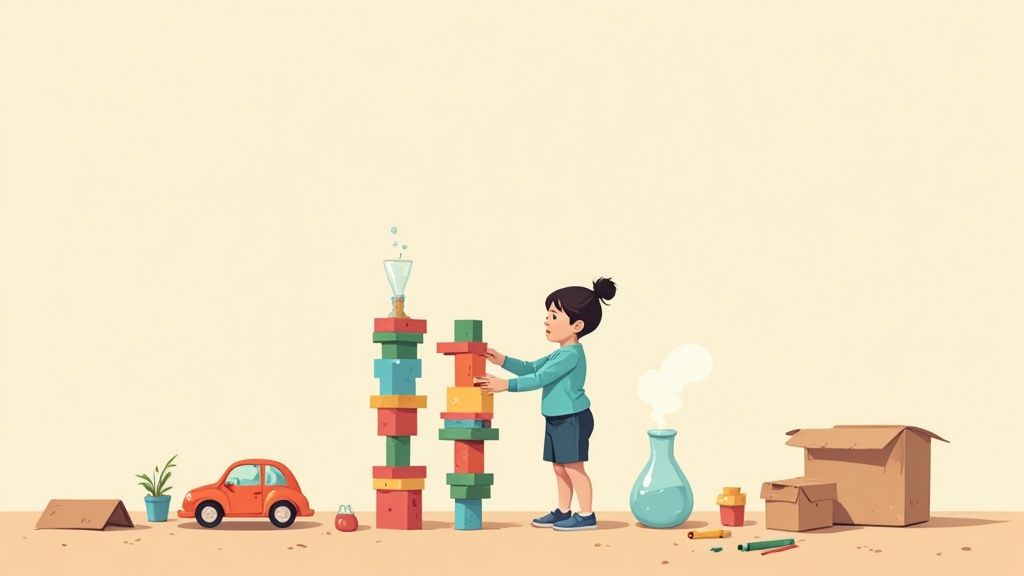
Play-based learning is a pretty intuitive idea, one that parents and educators have understood for generations: children learn best when they're having fun. It’s an educational approach that ditches rigid lesson plans in favor of exploration, curiosity, and play. Instead of seeing play as a break from learning, it recognizes play as the main event.
This approach is all about using a child's natural desire to play as the primary way to build crucial cognitive, social, and emotional skills.
Unpacking the Meaning of Play Based Learning
So, what is play based learning when you really get down to it?
Picture a toddler totally absorbed in building a wobbly tower of blocks. To us, it might just look like stacking. But in their world, they're a little scientist and an engineer all rolled into one. They're running hands-on experiments with gravity, balance, and what makes a structure stand up (or tumble down).
That's the heart of it. Play-based learning reframes these everyday childhood activities, recognizing them as powerful, organic learning moments.
The Core Idea: A Guided Adventure
Think of it less like a formal classroom lesson and more like a guided adventure. The child is firmly in the driver's seat, deciding which path to take and what to explore. The adult—whether a parent or a teacher—is the supportive co-pilot.
Your job isn't to lecture or direct. It’s to create an amazing environment packed with interesting things and then gently guide the discovery process as it unfolds. You might ask a thought-provoking question or introduce a new prop, but the child is the one leading the expedition.
In this model, play isn't just a fun distraction. It’s the real work of childhood. It’s the laboratory where kids learn to negotiate, solve tricky problems, and build the bedrock skills they'll need for all future learning.
This philosophy truly honors a child’s innate curiosity. When a group of kids hosts a pretend tea party, they aren't just messing around. They’re practicing language, navigating social rules, and learning how to cooperate. There are no flashcards in sight, yet deep, meaningful learning is happening constantly.
For those interested in the professional side of facilitating this kind of growth, exploring the principles of Playwork can offer a much deeper understanding.
Different Flavors of Play
Play-based learning isn’t just one thing; it’s more of a spectrum. Knowing the different "flavors" of play helps you see how this philosophy comes to life in different situations.
This isn't about choosing one "right" way. It's about understanding how the level of adult involvement can shift, from completely unstructured free-for-alls to activities with a bit more of a framework.
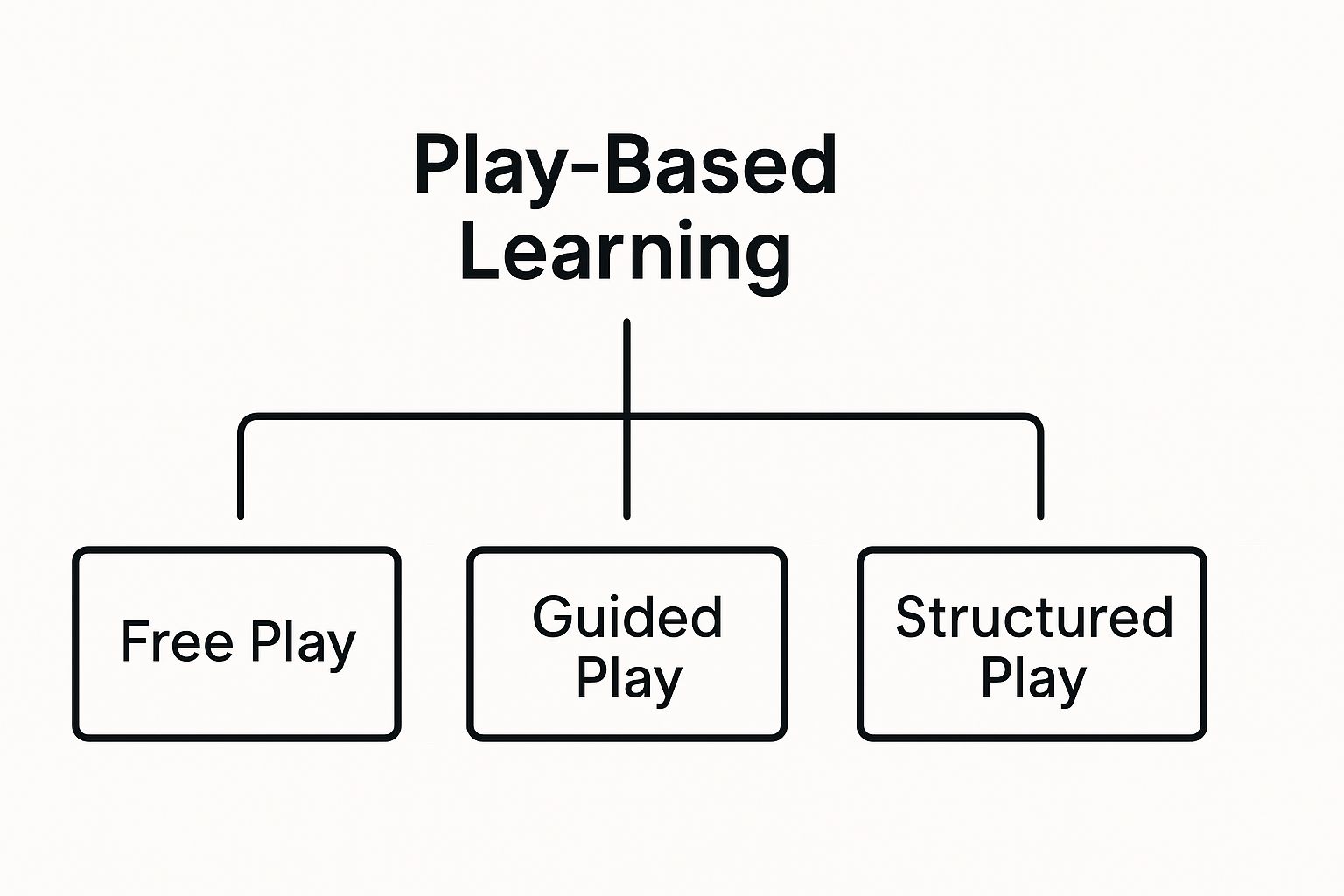
To make sense of this, let's look at the three main styles of play you'll see in a play-based approach.
A Quick Guide to Different Types of Play
This table breaks down the different approaches within play-based learning, from unstructured exploration to activities with more adult involvement.
| Type of Play | What It Looks Like | Key Learning Outcome |
|---|---|---|
| Free Play | The child is the boss. They're making a fort out of pillows or a "potion" from mud and leaves. It's 100% child-led and spontaneous. | Fostering creativity, independence, and problem-solving on their own terms. |
| Guided Play | An adult gently steers the fun. While playing with toy animals, a parent might ask, "I wonder what sound the lion makes?" or "Where does the giraffe live?" | Nudging a child toward a specific learning goal (like animal sounds or habitats) without taking over the game. |
| Structured Play | This has more rules and a clear objective, led by an adult. Think of playing a board game, following a recipe together, or doing a group craft project. | Teaching skills like following directions, taking turns, and working toward a shared goal. |
Ultimately, the best approach is a healthy mix of all three. This "play diet" gives kids the freedom their imaginations need to run wild, while also creating moments for more intentional skill-building. It’s the perfect balance.
Why Is Everyone Talking About Learning Through Play?
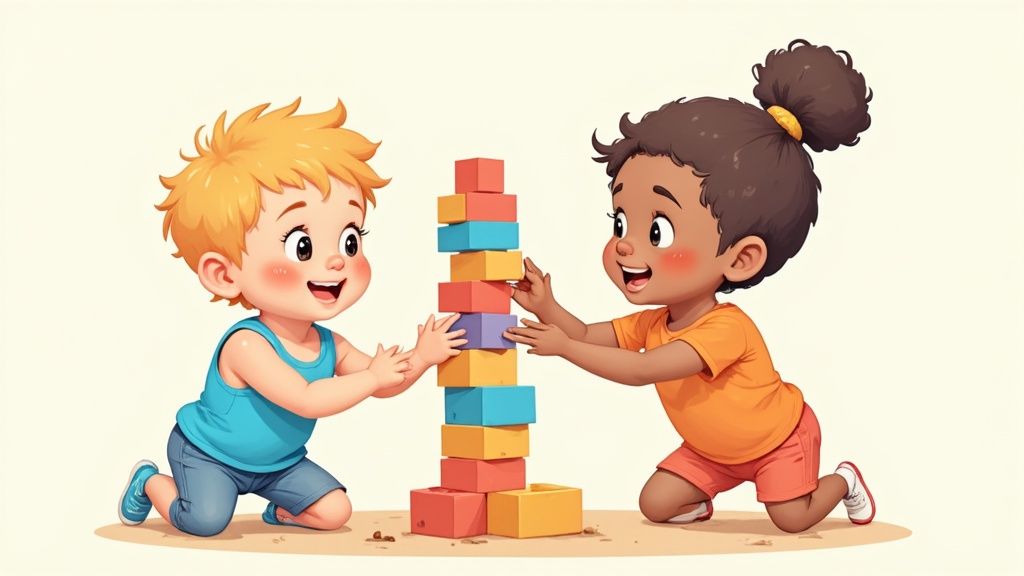
It might feel like "play-based learning" is the latest buzzword popping up in every parent-teacher conference and blog post, but the idea is anything but new. It has deep roots in educational philosophy, and right now, it’s picking up serious steam with parents, caregivers, and teachers all over the world. This isn't just some passing fad; it's a powerful, research-backed way of teaching that's becoming a cornerstone of modern education.
This renewed excitement comes from a much clearer picture of how a child's brain actually develops. As academic pressure on young kids seems to climb higher and higher, many experts are hitting the brakes. They see that an approach centered on play is absolutely essential for building not just academic skills, but also the emotional grit and social smarts kids need to navigate a complicated world.
Frankly, it's the perfect antidote to the risk of burnout before elementary school even gets going. The conversation has shifted from seeing play as just a fun break to recognizing it as a strategic tool for hitting crucial developmental milestones. It lays the groundwork for a lifetime of curiosity and a real love for learning.
The Science Behind the Fun
The global education community is pouring a ton of resources into understanding what is play based learning and how it truly works. This isn't just talk; it's backed by a mountain of evidence. We've seen a huge spike in empirical research, especially in major English-speaking countries where educators are taking a hard look at its impact.
One massive 2025 systematic review dug into 87 different studies on the topic. The research came from all over, but the biggest contributors were Canada (15 studies), the United States (10 studies), and the United Kingdom (9 studies). This widespread focus tells us that a global agreement is taking shape around the importance of play. You can read the full research on play-based learning to get a sense of just how deep these findings go.
This intense focus also highlights something really important about when it’s most effective. It’s not just for toddlers. The research shows a significant concentration on children aged 5–11, covering that entire critical stretch from kindergarten through fifth grade.
Why This Age Group Is So Important
The focus on the 5-to-11-year-old crowd is no coincidence. This period is a massive developmental window where kids are moving from purely informal, at-home learning to the more structured world of school. Play-based learning acts as the perfect bridge between these two worlds.
During these elementary years, children are building the core frameworks for things like:
- Problem-Solving: Figuring out how to share one coveted toy or how to build a Lego tower that doesn't immediately topple over are low-stakes, high-impact lessons in critical thinking.
- Social Negotiation: Play is a constant workout for communication, turn-taking, and empathy. Learning to work through a disagreement in a game is direct practice for navigating relationships in real life.
- Emotional Regulation: When that block tower does fall or a game doesn't go their way, kids get to practice managing frustration and disappointment in a safe, controlled environment.
- Creative Thinking: An empty cardboard box isn't just a box; it's a rocket ship, a castle, or a secret fort. This kind of imaginative thinking is what fuels innovation and adaptability later on.
By making these skills a priority, play-based learning doesn't just prepare kids for their next math test. It prepares them for the unpredictable challenges and collaborative opportunities of the real world.
As academic demands increase, this approach ensures that the joy of discovery stays right at the heart of education. It protects a child's natural curiosity and stops learning from feeling like a chore. Instead of just drilling facts, we're inviting them to uncover knowledge for themselves—which is a far more powerful and lasting way to learn. It ensures that as children grow, their desire to learn grows right along with them.
The Real-World Payoff of Learning Through Play
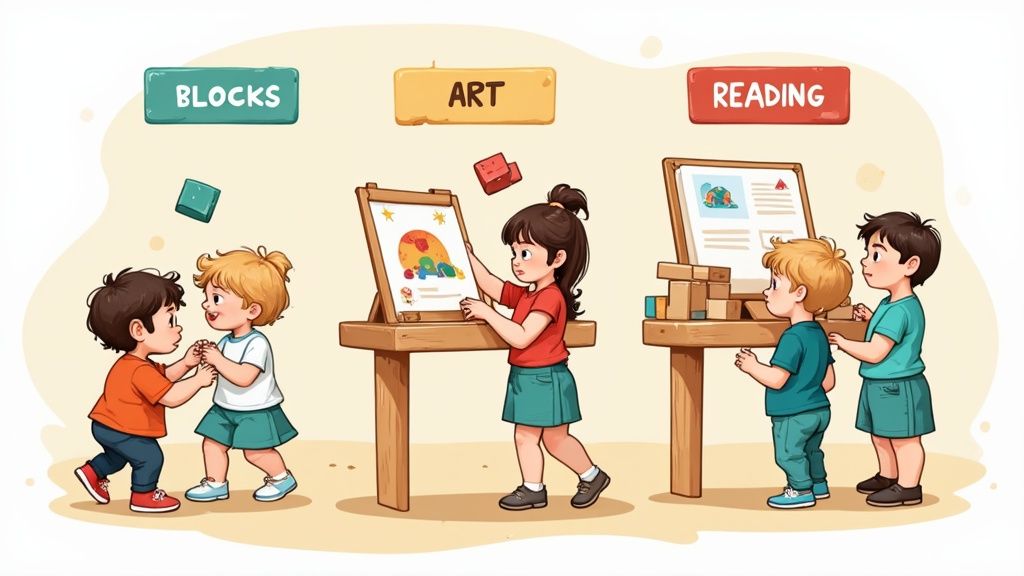
When we talk about play-based learning, it’s easy to get stuck on the "fun" part. But underneath all the giggles and games, children are secretly building a powerful toolkit of real-world skills. This isn't just about keeping kids entertained; it’s a brilliant strategy for nurturing well-rounded development, from brainpower to social smarts.
These benefits aren't just abstract ideas. They show up in very real ways, connecting simple playtime moments to huge developmental leaps. Every tower built, every messy art project, and every argument over game rules is a stepping stone. This isn't just fun—it's foundational.
Cognitive and Academic Growth
At a glance, a toddler splashing in a puddle is just making a mess. But if you look closer, you'll see a tiny scientist in action. They’re conducting experiments in real-time, learning about cause and effect (the bigger the splash, the wetter my pants), physics (how water moves), and sensory details (the difference between mud and water). Trust me, that hands-on lesson sticks way better than any textbook diagram ever could.
The same goes for building with blocks. It’s basically a masterclass in engineering, spatial awareness, and problem-solving. A child has to figure out how to build a stable base, how to balance the pieces, and what to do when their masterpiece inevitably comes crashing down. These are the exact same principles behind the complex math and physics they’ll tackle later in school.
This isn’t just a new idea, either. Researchers have known for a long time that play directly boosts academic skills. Studies going all the way back to the early 2000s show that kids in play-based programs have stronger social skills, reading abilities, and math comprehension. If you want to see just how deep these connections run, you can discover more about these foundational findings on play-based learning.
Social and Emotional Superpowers
Play is, without a doubt, the number one training ground for getting along with other people. When a group of kids tries to agree on the rules for a game of tag or decides who gets to be the "doctor," they are practicing essential social skills in a safe, low-stakes setting.
These interactions teach them how to:
- Communicate Their Ideas: They learn to speak up, listen to their friends, and find a way to work together.
- Negotiate and Compromise: Play is full of little conflicts. Sorting them out teaches kids how to give and take and to see things from someone else's point of view.
- Develop Empathy: When a child pretends to be a parent comforting a doll, they are literally stepping into someone else's shoes and learning to understand their feelings.
- Practice Self-Control: Dealing with the frustration of losing a game or having to wait for their turn builds incredible emotional regulation.
A child who successfully navigates the complex social world of the playground is building the exact same skills they'll need for a group project in high school or a team assignment at their future job.
Language and Literacy Development
The link between play and language is incredibly powerful. A play-based classroom or home is naturally a language-rich one, where conversations happen all the time.
Just picture a few preschoolers running a pretend restaurant. They're constantly talking—taking "orders," describing the "food," and chatting with their "customers." This isn't just noise; it's an immersive language lesson. They're growing their vocabulary, trying out new sentence structures, and getting the hang of back-and-forth conversation. For more ideas on sparking this kind of growth, take a look at our guide to early childhood development activities.
Storytelling is another huge piece of the puzzle. When a child makes up a story for their toy dinosaurs, they're developing core literacy skills:
- Narrative Skills: They learn that stories need a beginning, a middle, and an end.
- Sequencing: They practice putting events in a logical order.
- Creative Expression: They use words to build entire worlds and characters right out of their imagination.
These skills are the bedrock of reading comprehension and writing. By encouraging this kind of imaginative play, you're nurturing a future bookworm and writer without a single worksheet in sight. It just goes to show that the most powerful learning often happens when a child doesn't even realize it's happening at all.
When you hear "play-based learning," it’s easy to lump all play into one big, happy category. But if you really want to unlock its power, you need to know about two distinct flavors of play: free play and guided play.
Think of it like this: one is pure, spontaneous invention, and the other adds a gentle sprinkle of adult wisdom to help steer the discovery. Knowing the difference—and when to use each—is the secret to creating a perfectly balanced "play diet" for your child.
The Wild Freedom of Free Play
Free play is exactly what it sounds like. It’s 100% child-led, spontaneous, and fueled purely by imagination. This is what happens when you hand a kid a pile of cardboard boxes and, with zero input from you, they build an elaborate spaceship to explore the galaxy.
In free play, your child is the director, scriptwriter, and star of their own show. There are no rules except the ones they invent on the fly, and no end goals other than the ones they create in the moment. This is where their creativity truly runs wild.
What does free play look like?
- Total Autonomy: The child decides what to play, how to play with it, and when the game is over.
- Unstructured Exploration: The focus is on the doing, not the final product. The joy is in the journey, not a perfect creation.
- Intrinsic Motivation: The drive comes completely from within, sparked by nothing more than curiosity and fun.
This kind of play is an absolute powerhouse for building independence, creativity, and the confidence to solve problems on their own terms. It’s where a child learns to trust their own brilliant ideas.
The Gentle Nudge of Guided Play
Guided play is where the magic of collaboration comes in. It starts with a child's natural curiosity but involves a thoughtful adult who gently steers the activity toward a specific learning goal. You're a co-pilot, not a controller.
Let’s head back to that cardboard spaceship. In a guided play scenario, you might join the fun and ask, "I wonder how we could make this spaceship strong enough to hold your favorite teddy bear astronaut?" All of a sudden, you've introduced a fun little challenge. Without taking over, you’ve nudged them toward concepts of engineering and problem-solving.
Guided play is the art of asking the right questions. It honors the child’s lead while intentionally weaving in learning opportunities, making education feel like a shared adventure.
This approach perfectly blends the child's freedom with the benefits of intentional teaching. It’s a subtle but incredibly effective way to introduce new vocabulary, expand on ideas, and encourage deeper thinking—all without ever feeling like a lesson.
And the research backs this up. A recent analysis found that play-based approaches, especially guided play, can boost a child's early academic progress by an average of four additional months compared to traditional methods. The biggest gains were seen in language, literacy, and math. You can learn more about these play-based learning findings to see just how impactful this gentle guidance can be.
So, Which One is Better? Finding the Perfect Balance
Here’s the thing: it’s not a competition. A healthy play diet needs a generous helping of both.
Free play is absolutely essential for building a child’s inner world, their confidence, and that creative spark. It’s their time to be the boss. On the other hand, guided play is your chance to connect with them, expand their horizons, and introduce new concepts in a way that feels like a game.
By making time for both, you give your child the best of both worlds. You empower them to be independent thinkers while also providing the support they need to stretch their skills. It's this beautiful balance that truly unlocks the full potential of learning through play.
Creating a Rich Play Environment at Home
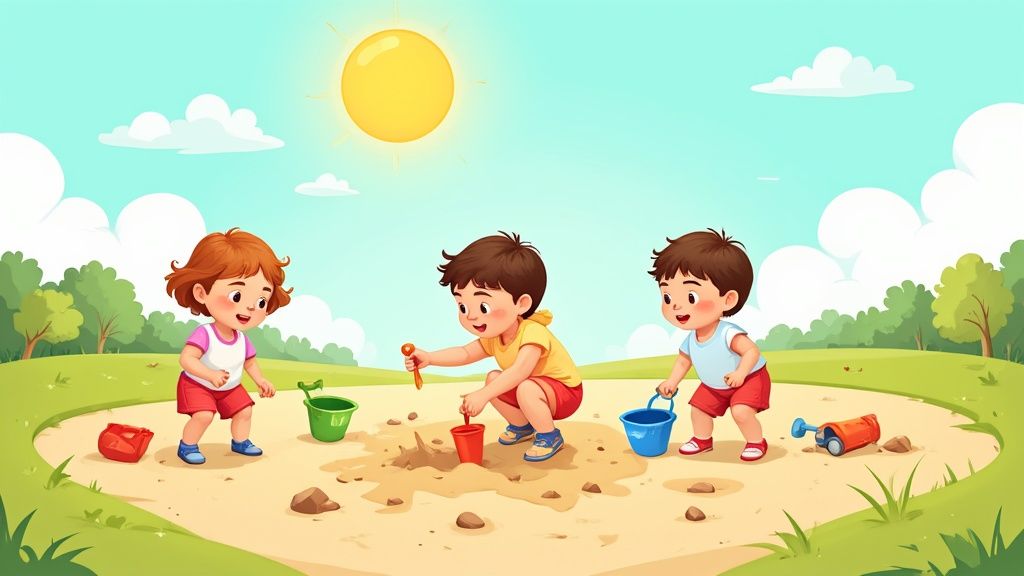
Ready to bring play-based learning into your home? The best part is you don't need a perfectly organized, catalog-worthy playroom or a trunk overflowing with expensive "educational" toys. A truly rich play environment is less about what you buy and more about what you make available.
You can transform your living space into a landscape of discovery with simple, everyday items. It’s all about creating small, irresistible "invitations to play" that spark your child's natural curiosity and let their imagination take the lead.
Start with Open-Ended Materials
The most powerful toys are often not toys at all. They're what we call open-ended materials—items that can be used in countless ways, limited only by a child's imagination. Unlike a toy with a single, clear purpose, these items can become anything.
A simple cardboard box is the perfect example. It isn't just a box; it can be a race car, a castle, a robot costume, or a secret clubhouse. This flexibility is what fires up creative thinking and real-world problem-solving.
Here are some household treasures that are perfect for open-ended play:
- Kitchen Utensils: Whisks, measuring cups, and silicone spatulas are fantastic for "potion-making stations" or a pretend bakery.
- Recycled Containers: Clean yogurt cups, egg cartons, and plastic bottles become building blocks, sorting trays, or musical instruments.
- Blankets and Pillows: These are the essential ingredients for building epic forts, cozy nests, or challenging obstacle courses.
- Natural Items: Sticks, leaves, smooth stones, and pinecones collected from a walk bring a wonderful sensory element to indoor play.
The goal isn't to provide a finished product but to provide the raw materials for creation. When a child has to figure out how to make a blanket stay up or how to stack containers without them falling, they are engaged in high-level critical thinking.
This hands-on approach builds an incredible foundation, showing that exploration can happen anywhere, with anything. For even more inspiration, you can find a wealth of creative activities for preschoolers that use items you already have.
Design Invitations to Play
An "invitation to play" is simply a thoughtfully arranged collection of materials that piques a child's interest. It's not about setting up a complicated activity with strict rules. Think of it as presenting a question without words, like, "I wonder what you could do with this?"
This approach is incredibly effective because it respects a child's autonomy. You're just setting the stage; they get to be the director of the show.
Simple Invitation Ideas:
- Potion-Making Station: On a tray, place a few clear containers, a pitcher of water (maybe with a drop or two of food coloring), and a whisk or spoon. This simple setup invites experiments with color mixing and cause and effect.
- Dough and Nature: Set out a ball of play-doh alongside a collection of pinecones, small sticks, and leaves. This encourages children to explore texture, make impressions, and create unique sculptures.
- Rescue the Animals: Use painter's tape to gently stick a few small plastic animals to a baking sheet. Give your child the "mission" to carefully peel the tape and rescue them—a fantastic exercise for fine motor skills.
These setups take just minutes to create but can lead to hours of focused, self-directed learning. They are the heart of a successful play-based environment at home. For those looking to extend this kind of discovery outdoors, resources on building a DIY backyard play area can be invaluable.
The key is to observe what your child is currently interested in and build from there. If they're fascinated by bugs, your next invitation might involve a magnifying glass and some plastic insects. Follow their lead, and you'll find that learning naturally blossoms in every corner of your home.
Answering Your Top Questions About Play-Based Learning
It’s totally normal to have questions when you’re looking at your child's learning in a new way. The idea that something as fun as "just playing" can also be serious, foundational learning is a big shift for a lot of parents.
Let's walk through some of the most common questions and worries that come up. My goal is to give you clear, reassuring answers so you feel great about jumping into this amazing approach.
Is My Child Really Learning if They Just Play All Day?
Yes, a thousand times yes! This is probably the biggest mental hurdle for parents, but the science on this is absolutely clear: for young kids, playing is learning. They aren't two separate things; they're completely intertwined.
When a child is lost in the world of building a block tower, negotiating the rules of a pretend game, or simply squishing different textures in their hands, their brain is firing on all cylinders. They are actively building the foundation for all future academic success.
Think of it this way: play is the brain's favorite way of learning. It’s not a break from education; it’s education perfectly woven into the activities children are naturally wired to do.
They're developing critical skills like:
- Critical thinking
- Problem-solving
- Emotional regulation
- Social negotiation
These aren't just "soft skills." They are the essential tools that allow a child to understand their world, solve problems, and connect with others.
How Does This Prepare My Child for Formal Schooling?
This is a fantastic and super important question. The truth is, a quality play-based approach is the ultimate preparation for school. Instead of just memorizing letters and numbers in a vacuum, it builds the core skills that allow a child to actually use that knowledge and thrive in a classroom setting.
A child who has spent years immersed in rich, imaginative play learns how to:
- Focus on a task they care about.
- Work with other kids to reach a shared goal.
- Think creatively when things don't go as planned.
- Stay curious and develop a genuine love for discovery.
The magic happens when you start weaving "academic" ideas into their play. Playing "grocery store" becomes a dynamic math lesson. Reading a story and then acting it out builds literacy skills that go way deeper than a worksheet. A scavenger hunt for things that start with 'B' is a phonics lesson they'll actually remember. It’s not a detour from formal education; it's the strongest, most engaging on-ramp you can possibly build.
Do I Need to Buy Special Educational Toys?
Definitely not. In fact, some of the best materials for developmental play are the simplest and cheapest things you can find. The most powerful tools are open-ended materials—things that can be used in a million different ways.
Think about it: a fancy electronic toy that sings the alphabet has one job. A simple set of wooden blocks, however, can be a castle, a bridge, a spaceship, or a pattern puzzle. The blocks demand that the child bring the imagination, and that's the whole point.
Before you rush out to buy expensive "learning" toys, just look around your house. You've probably got a goldmine of amazing play materials like cardboard boxes, blankets, pots and pans, and old containers. These everyday items encourage far more creativity and problem-solving than most things you can buy in a store.
What if My Child Isn't Interested in My Play Ideas?
This is a brilliant learning opportunity—for you! If you set up a beautiful "invitation to play" and your child wanders off to do something else entirely, it's a perfect reminder that real play-based learning is child-led.
Don't push it or feel like you failed. Instead, take a breath, step back, and watch what they are doing. Their natural curiosity is your roadmap. If they're fascinated by how a toy car's wheels spin, get down on the floor and explore motion with them. If they're carefully lining up their stuffed animals, you can casually introduce ideas about patterns or counting.
Following their lead is the heart of this whole philosophy. It's also a fantastic way to build their social and emotional skills; for more ideas on this, check out these wonderful social-emotional learning activities that fit perfectly into their play. Your job isn't to be the director of fun, but a curious, responsive partner in their discovery. When you follow their interests, you're sending the most important message of all: your ideas are valuable.
Ready to spark your child's creativity with activities they design themselves? At ColorPageAI, you can turn any idea—from a "dinosaur playing soccer" to an "astronaut unicorn"—into a unique coloring page in seconds. It’s a perfect tool for play based learning, letting your child's imagination lead the way. Generate your first five coloring pages for free at https://colorpage.ai.
Ready to start coloring?
Join ColorPage.ai today and get 5 free credits to create your own custom coloring pages!
Start creating